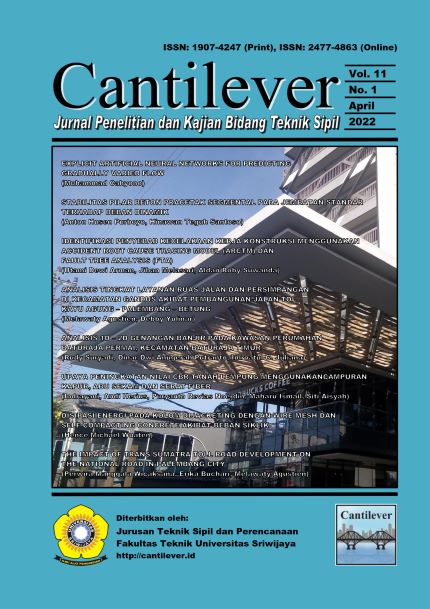Explicit Artificial Neural Networks For Predicting Gradually Varied Flow Jaringan Syaraf Tiruan Eksplisit untuk Memprediksi Aliran Berubah Beraturan
Main Article Content
Abstract
The ANN procedure was used to develop an explicit equation for predicting the water level profile in a gradually varied flow. The equation consists of a series of hyperbolic tangent functions, with the number of series being the same as the number on the node in the hidden layer. The ANN model consists of 3 layers: the input layer consists of four nodes, the hidden layer has seven nodes and one node in the output layer. The input parameters used are parameters related to distance, discharge, roughness, and depth of flow at the downstream end of the channel. The output parameter is the flow depth at various points. The model has been used to estimate the water level profile for different flow conditions. The comparison between the explicit ANN model and the numerical model results is satisfactory. The models can be extended to study more complex flows and non-prismatic channels. The model is promising as a tool in decision support.
Downloads
Article Details
Aqil, M., Kita, I. Yano,A. and Nishiyama, S. (2007). Neural networks, for real time catchment flow modeling and prediction. Water Resour. Manag, 21(10), 1781-1796.
Chapra, S. C. and R. P. Canale. (2015). “Numerical Methods for Engineers”, 2th Ed., McGraw-Hill Education.
Cheng, M., Fang, F., Kinouchi, T., Navon, I.M., Pain, C.C. (2020). Long lead-time daily and monthly streamflow forecasting using machine learning methods. Journal of Hydrology. doi: https:// doi.org/10.1016/j.jhydrol.2020. 125376
Cigizoglu, H. K., Kisi, O. (2006). Methods to improve the neural network performance in suspended sediment estimation. J. of Hydrology, 317, 221–238.
Dibike, Y. B. and D.P. Solomatine, D. P. (2001). River flow forecasting using artificial neural networks. Phys. Chem. Earth Part B Hydrol. Ocean. Atmos, 26(1), 1-7.
Fu, M., Fan, T., Ding, Z., Salih, S. Q., Al-Ansari, N., and Yaseen, Z. M. (2020). Deep learning data-intelligence model based on adjusted forecasting window scale: application in daily streamflow simulation. IEEE Access, 8, 32632–3265.
Haykin, S. (1999). Neural Networks: A Comprehensive Foundation; Prentice-Hall: Englewood Cliffs, NJ, USA.
Huo, Z., Feng, S., Kang, S., Huang, G., Wang, F., Guo, P. (2012). Integrated neural networks for monthly river flow estimation in arid inland basin of Northwest China. J. Hydrol, 420, 159–170.
Hu, C., Wu, Q., Li, H., Jian, S., Li, N., and Lou, Z. (2018). Deep Learning with a Long Short-Term Memory Networks Approach for Rainfall-Runoff Simulation. Water, 10(11), 1543.
Imrie, C. E., Durucan, E., and Korre, A. (2000). River flow prediction using artificial neural networks: generalisation beyond the calibration range. J. Hydrol, 233 (1–4), 138-153.
Kisi, O. (2008). Constructing neural network sediment estimation models using a data-driven algorithm. Mathematics and Computers in Simulation, 79(1), 94-103.
Mosavi, A., & Ozturk, P. (2018). Flood prediction using machine learning models: literature review. Water, 10, 1536.
Liu, D., Jiang, W., Mu, L. and Wang, S. (2020). Streamflow prediction using deep learning neural network: case study of Yangtze River. IEEE Access, 8, 90069–90086.
Ni, Q., Wang,L., Ye, R., Yang, F., and Sivakumar, M. (2010). Evolutionary modeling for streamflow forecasting with minimal datasets: a case study in the West Malian River, China. Environ. Eng. Sci. 27(5), 377–385. http://doi.org/10.1089/ees.2009.0082
Noori, N. & Kalin, L. (2016). Coupling SWAT and ANN models for enhanced daily streamflow prediction. J. Hydrol. 533, 141–151.
Omid, M. H., Omid, M., and Esmaeeli Varaki, M. (2005). Modelling hydraulic jumps with artificial neural networks. Proceedings of the Institution of Civil Engineers Water Management, 158, 65–70.
Riahi-Madvar, H., and Seifi, A. (2018). Uncertainty analysis in bed load transport prediction of gravel bed rivers by ANN and ANFIS’. Arabian J.Geosci, 11. https://doi.org/10.1007/s12517-018-3968-6
Rojas, R. (1996). Neural Networks A Systematic Introduction. Springer, Berlin.
Sahraei, S.M.R., Alizadeh, N., Talebbeydokhti, M., Dehghani. (2017). Bed material load estimation in channels using machine learning and meta-heuristic methods. J. Hydroinf, 100-116. https://doi.org/10.2166/hydro.2017.129
Subramanya, K. (2009). Flow in Open Channels. Tata McGraw-Hill Publishing Company Limited, NEW DELHI, 3rd Ed.
Xiang, Z., & Demir, I. (2020). Distributed long-term hourly streamflow predictions using deep learning—a case study for State of Iowa. Environ. Modell Softw. 131, 104761.
Xiang, Z., Yan, J., & Demir, I. A. (2020). Rainfall-runoff model with LSTM-based sequence-to-sequence learning. Water Resour. Res. 56(1), e2019WR02532.

This work is licensed under a Creative Commons Attribution-NonCommercial 4.0 International License.
Authors who publish with this journal agree to the following terms:
- Authors retain copyright and grant the journal right of first publication with the work simultaneously licensed under a Creative Commons Attribution-NonCommercial 4.0 International License that allows others to share the work with an acknowledgment of the work's authorship and initial publication in this journal.
- Authors are able to enter into separate, additional contractual arrangements for the non-exclusive distribution of the journal's published version of the work (e.g., post it to an institutional repository or publish it in a book), with an acknowledgment of its initial publication in this journal.
- Authors are permitted and encouraged to post their work online (e.g., in institutional repositories or on their website) prior to and during the submission process, as it can lead to productive exchanges, as well as earlier and greater citation of published work (See The Effect of Open Access).
